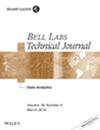下载PDF
{"title":"突发交换光网络的新视角","authors":"Giorgio Cazzaniga, Christian Hermsmeyer, Iraj Saniee, Indra Widjaja","doi":"10.1002/bltj.21630","DOIUrl":null,"url":null,"abstract":"<p>Recent experimental research in coherent detection has enabled 100G (or higher bit-rate) optical receivers to switch between wavelengths in less than a hundred nanoseconds. Such technologies enable a novel variant of the Time-domain Wavelength Interleaved Networks (TWIN) architecture in which fast tunable receivers replace tunable transmitters as the main switching elements in the otherwise passive optical network. Similar to TWIN, this architecture enables efficient sharing of 100G (or higher) wavelength rates among multiple destinations in metro networks or data centers where individual node-pairs may not need the full capacity of each wavelength. In this paper, we present the key elements of this novel variant of TWIN, discuss framing and scheduling efficiency, sub- and super-framing for TDM and packet data, as well as protection mechanisms. We also present the benefit of this approach relative to other optical network technologies. We conclude with an overview of the potential applications of this novel optical networking architecture. © 2013 Alcatel-Lucent.</p>","PeriodicalId":55592,"journal":{"name":"Bell Labs Technical Journal","volume":"18 3","pages":"111-131"},"PeriodicalIF":0.0000,"publicationDate":"2013-11-27","publicationTypes":"Journal Article","fieldsOfStudy":null,"isOpenAccess":false,"openAccessPdf":"https://sci-hub-pdf.com/10.1002/bltj.21630","citationCount":"8","resultStr":"{\"title\":\"A New Perspective on Burst-Switched Optical Networks\",\"authors\":\"Giorgio Cazzaniga, Christian Hermsmeyer, Iraj Saniee, Indra Widjaja\",\"doi\":\"10.1002/bltj.21630\",\"DOIUrl\":null,\"url\":null,\"abstract\":\"<p>Recent experimental research in coherent detection has enabled 100G (or higher bit-rate) optical receivers to switch between wavelengths in less than a hundred nanoseconds. Such technologies enable a novel variant of the Time-domain Wavelength Interleaved Networks (TWIN) architecture in which fast tunable receivers replace tunable transmitters as the main switching elements in the otherwise passive optical network. Similar to TWIN, this architecture enables efficient sharing of 100G (or higher) wavelength rates among multiple destinations in metro networks or data centers where individual node-pairs may not need the full capacity of each wavelength. In this paper, we present the key elements of this novel variant of TWIN, discuss framing and scheduling efficiency, sub- and super-framing for TDM and packet data, as well as protection mechanisms. We also present the benefit of this approach relative to other optical network technologies. We conclude with an overview of the potential applications of this novel optical networking architecture. © 2013 Alcatel-Lucent.</p>\",\"PeriodicalId\":55592,\"journal\":{\"name\":\"Bell Labs Technical Journal\",\"volume\":\"18 3\",\"pages\":\"111-131\"},\"PeriodicalIF\":0.0000,\"publicationDate\":\"2013-11-27\",\"publicationTypes\":\"Journal Article\",\"fieldsOfStudy\":null,\"isOpenAccess\":false,\"openAccessPdf\":\"https://sci-hub-pdf.com/10.1002/bltj.21630\",\"citationCount\":\"8\",\"resultStr\":null,\"platform\":\"Semanticscholar\",\"paperid\":null,\"PeriodicalName\":\"Bell Labs Technical Journal\",\"FirstCategoryId\":\"1085\",\"ListUrlMain\":\"https://onlinelibrary.wiley.com/doi/10.1002/bltj.21630\",\"RegionNum\":0,\"RegionCategory\":null,\"ArticlePicture\":[],\"TitleCN\":null,\"AbstractTextCN\":null,\"PMCID\":null,\"EPubDate\":\"\",\"PubModel\":\"\",\"JCR\":\"Q1\",\"JCRName\":\"Engineering\",\"Score\":null,\"Total\":0}","platform":"Semanticscholar","paperid":null,"PeriodicalName":"Bell Labs Technical Journal","FirstCategoryId":"1085","ListUrlMain":"https://onlinelibrary.wiley.com/doi/10.1002/bltj.21630","RegionNum":0,"RegionCategory":null,"ArticlePicture":[],"TitleCN":null,"AbstractTextCN":null,"PMCID":null,"EPubDate":"","PubModel":"","JCR":"Q1","JCRName":"Engineering","Score":null,"Total":0}
引用次数: 8
引用
批量引用

 求助内容:
求助内容: 应助结果提醒方式:
应助结果提醒方式:


